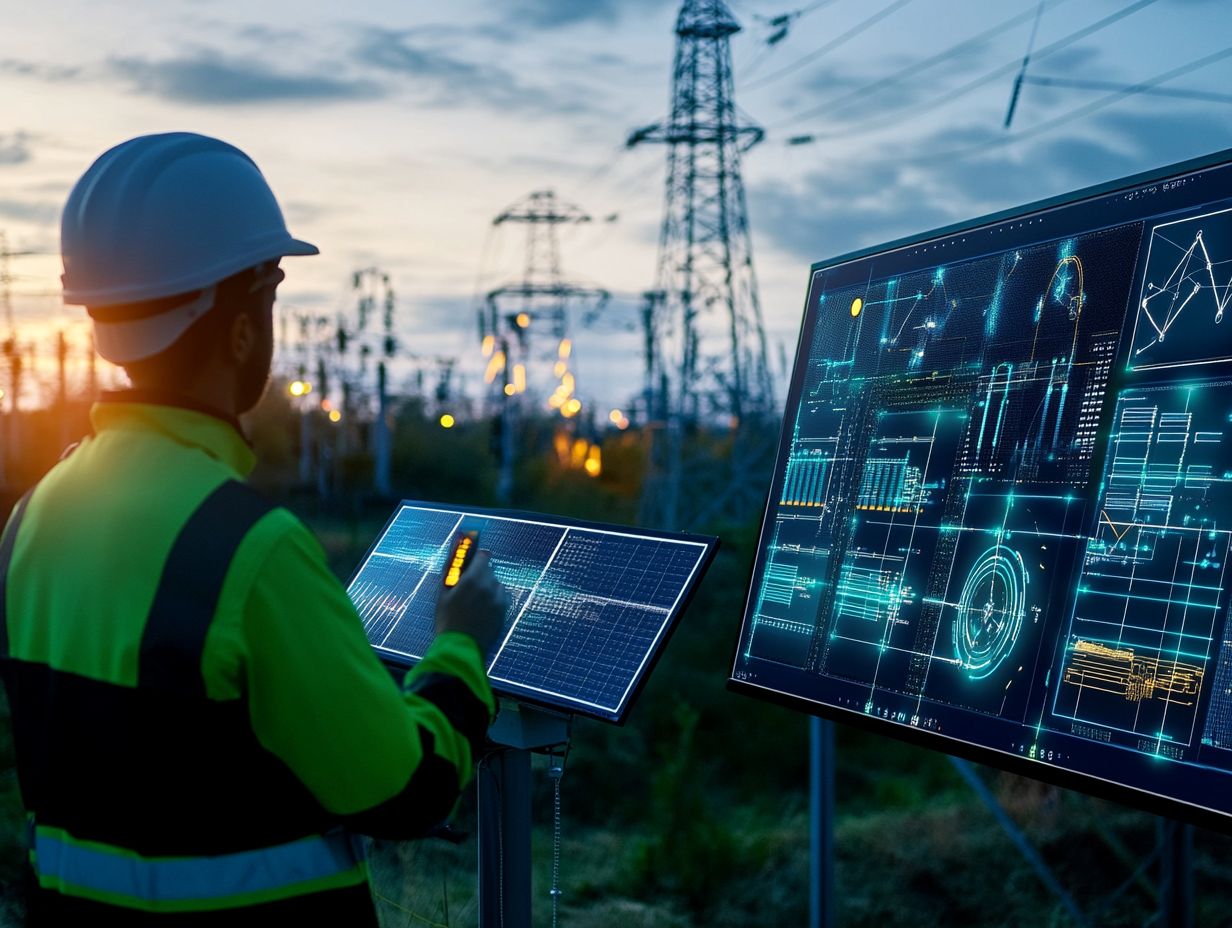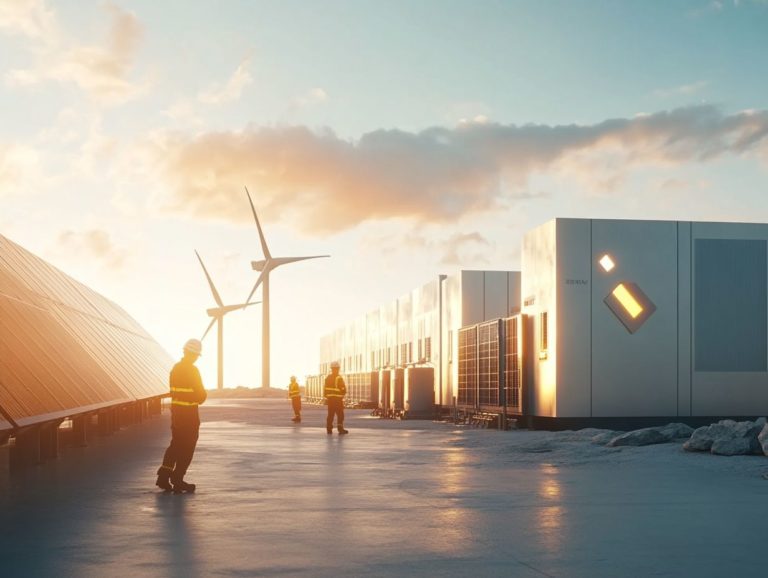How to Transition from Grid to Energy Storage
In today s rapidly evolving energy landscape, grasping the intricacies of the grid and energy storage is vital for making informed decisions about your energy future. Don t miss out on the chance to understand how energy storage can revolutionize your energy future.
This article delves into what the grid is and how it operates in conjunction with energy storage systems that offer both efficiency and sustainability.
You ll discover the myriad benefits of transitioning to energy storage from environmental advantages to significant cost savings while also considering the challenges that may arise.
We ll provide you with practical steps to successfully shift from traditional grid reliance to innovative energy storage solutions.
Together, let s navigate this essential topic, paving the way for a cleaner, more resilient energy future.
Contents
- Key Takeaways:
- Understanding the Grid and Energy Storage
- Benefits of Transitioning to Energy Storage
- Challenges and Considerations
- Steps to Transition from Grid to Energy Storage
- Frequently Asked Questions
- How do I transition from grid to energy storage?
- What are the benefits of transitioning from grid to energy storage?
- What challenges should I expect when transitioning from grid to energy storage?
- Do I need to completely disconnect from the grid when transitioning to energy storage?
- What role do policies and regulations play in transitioning from grid to energy storage?
- How can I ensure a smooth transition from grid to energy storage?
Key Takeaways:

- Transitioning to energy storage can bring environmental benefits, such as reducing carbon emissions and promoting renewable energy sources.
- This transition also enhances grid stability.
- It is important to consider the technical, regulatory, and policy challenges that come with transitioning to energy storage and plan accordingly.
- To successfully transition from grid to energy storage, evaluate your energy needs and choose the right system. Have a solid plan in place for implementation and maintenance.
Understanding the Grid and Energy Storage
Understanding the grid and energy storage is essential as you navigate the energy transition. Power systems are evolving to integrate renewable sources like solar and wind. This evolution ensures grid stability and enhances overall energy efficiency.
With the rise of battery storage technologies, systems such as lithium-ion batteries are becoming increasingly vital. They also play a crucial role in maintaining voltage stability and frequency response.
These technologies ensure operational continuity during grid disturbances, especially against disruptive events.
Key players in this field, such as SMA, AEMO, and Zenob Energy, are dedicated to advancing grid-following inverters and grid-forming technology. Their commitment helps optimize energy efficiency and reduce carbon emissions, not just in Australia, but across the globe, contributing to projects like the Blackhillock project.
What is the Grid and How Does it Work?
The electricity grid is a complex system that facilitates the distribution of electrical power from renewable generators to consumers. This system plays a vital role in maintaining grid stability and ensuring efficient energy delivery, which is key to supporting the integration of solar energy.
This intricate system comprises transmission lines, substations, and transformers that work in harmony to manage the flow of electricity. By integrating advanced power systems, it guarantees that energy from solar panels, wind turbines, and other renewable sources can be seamlessly supplied to your home or business.
Cutting-edge technologies like SMA’s advanced grid management solutions enhance real-time monitoring and control. This is essential for balancing supply and demand, particularly through demand response initiatives.
As a result, grid operators can optimize performance while minimizing disruptions. This ultimately supports a sustainable energy future that benefits everyone.
What is Energy Storage and How Does it Work?
Energy storage systems, especially battery technologies like lithium-ion batteries, are essential for balancing energy supply and demand. They provide frequency response to stabilize the grid during fluctuations, which is crucial for maintaining voltage stability.
These systems function by absorbing excess energy when demand is low and releasing it during peak consumption, ensuring a steady power flow.
Other energy storage solutions, such as pumped hydro, flywheels, and superconducting magnetic energy storage, also play crucial roles in maintaining grid stability, particularly managing short-circuit levels.
Each of these technologies operates on distinct principles. For example, pumped hydro harnesses gravitational potential energy, while flywheels store kinetic energy. Together, these systems enhance grid-following inverters, enabling rapid adjustments that support the increasingly variable energy landscape. For those interested in understanding more about these technologies, check out a beginner’s guide to energy storage systems.
Benefits of Transitioning to Energy Storage
Transitioning to energy storage systems offers you a wealth of benefits. These include improved energy efficiency, greater grid stability, and notable reductions in carbon emissions. These advantages position energy storage as a crucial element for achieving a sustainable energy future.
Environmental Benefits
The environmental benefits of transitioning to energy storage are remarkable. By embracing this shift, you facilitate a greater reliance on renewable energy sources while significantly slashing carbon emissions, contributing to a cleaner and more sustainable planet.
Energy storage systems enable a more reliable and flexible energy supply. They support the integration of variable renewables like solar and wind power, allowing these resources to work at their best. For a deeper understanding of how these systems interact with the energy grid, check out understanding the grid and renewable energy. This not only enhances overall energy efficiency but also sparks innovative solutions like green hydrogen production. This technology intelligently utilizes excess renewable energy to create sustainable fuel.
Ultimately, these advancements lead you toward a greener future. By minimizing reliance on fossil fuels and further reducing greenhouse gas emissions, you play an essential role in the effort to combat climate change. You can advocate for solutions such as green hydrogen.
Cost Savings
Imagine slashing your energy bills with energy storage! It enhances energy efficiency and reduces reliance on peak demand energy sources. This ultimately lowers your electricity costs, whether you re a consumer or a business.
This technology helps you manage your energy use strategically. By optimizing your operations, you boost your overall financial performance. By storing energy during off-peak times when prices drop, you can effectively ease the burden of high peak tariffs.
Energy storage systems also enable demand response systems. These systems help manage energy use during peak times, allowing you to participate in grid balancing initiatives. To maximize your benefits, consider learning how to integrate energy storage with solar panels, which can further cut your operational costs.
As utilities continue their shift toward more sustainable energy sources, integrating these systems supports your financial stability. This aligns with broader environmental goals, making transitioning from fossil fuels to renewables an attractive option for enterprises that seek to stay ahead of the curve.
Challenges and Considerations
Despite the myriad benefits, transitioning to energy storage systems presents a range of challenges. These include technical hurdles related to battery storage, along with the necessity of navigating regulatory and policy considerations to ensure grid stability and operational continuity.
Technical Challenges
A key challenge in energy storage systems is ensuring voltage stability and frequency response. This is especially important when integrating battery storage and grid-following inverters into existing power systems.
The dynamic behavior of these systems can significantly influence grid performance. This is true during periods of fluctuating demand or intermittent renewable energy inputs. Voltage stability becomes a pressing concern; any deviation can lead to inefficiencies or even operational failures.
For example, when a grid-following inverter must respond to sudden drops in voltage, it needs to swiftly adjust its power output. This responsiveness is crucial; inadequate performance in voltage regulation can destabilize the entire system.
This affects not just the battery storage units but also the broader electrical network. Such instability can potentially lead to outages or system damage.
Explore your options today and be part of the energy revolution!
Regulatory and Policy Considerations
Regulatory and policy considerations hold immense significance in your journey toward successful energy storage system implementation. They profoundly influence your energy efficiency strategies and compliance with standards established by entities like the Australian Renewable Energy Agency and AEMO.
These frameworks do more than just set the operational parameters for energy storage; they actively shape the economic landscape through a variety of incentives and funding opportunities. Government agencies frequently offer grants, tax credits, and rebates designed to stimulate innovation and lower the financial barriers for both individuals and businesses eager to adopt these technologies.
“`html
As you navigate the ever-evolving regulations, understanding compliance requirements is critical for maximizing the benefits available to you. This clear understanding can significantly enhance your integration of energy storage systems, contributing to a more resilient and sustainable energy future while aligning seamlessly with national goals aimed at reducing carbon emissions. For specific insights, refer to this guide on how to prepare for an energy storage upgrade.
“`
Steps to Transition from Grid to Energy Storage

Transitioning from a traditional electricity grid to energy storage systems demands a well-structured approach. You begin by thoroughly evaluating your energy needs, which sets the foundation for the journey ahead.
This thoughtful process leads to careful planning and ongoing maintenance of battery storage systems. This ensures operational continuity and efficiency throughout your energy management while preparing for the integration of advanced controls in your system.
Evaluating Energy Needs
Evaluating your energy needs is a vital first step in transitioning to energy storage. You need to dive deep into your energy use to make smart decisions!
This assessment isn’t just about crunching numbers; it requires a sophisticated grasp of peak consumption times, seasonal variations, and potential future demands. Carefully examining these factors helps you choose the right size and type of storage solution.
For example, if you’re looking to integrate renewable energy sources, a robust energy storage system will be essential to harmonize the intermittent supply with consistent demand. A comprehensive energy analysis not only uncovers inefficiencies but also optimizes performance, effectively reducing costs associated with energy waste. Learning how to create an off-grid energy system can also enhance your energy management strategy.
Ultimately, understanding your energy consumption is crucial. It will greatly enhance your selection process for appropriate storage systems, ensuring both reliability and sustainability.
Choosing the Right Energy Storage System
Choosing the right energy storage system is paramount for optimizing performance. This often requires you to navigate a spectrum of technologies, from lithium-ion batteries to grid-following inverters.
In this rapidly changing energy landscape, grasping the specific requirements of your project such as energy capacity, discharge duration (how long the system can provide energy after being charged), and cost is essential. For those looking to optimize their setup, learning how to implement energy storage in your home can provide valuable insights. Each technology presents its own set of advantages.
For instance, lithium-ion batteries are highly regarded for their impressive energy density and decreasing costs. In contrast, flow batteries excel in providing extended discharge times, making them ideal for large-scale applications.
You’ll also want to consider factors like charging speed, maintenance demands, and operational lifespan, as these further distinguish each system.
By thoroughly evaluating the trade-offs and benefits associated with each technology, you can make informed decisions that not only address your immediate energy needs but also align with your long-term sustainability goals.
Start assessing your energy needs today to pave the way for a sustainable future!
Implementing and Maintaining the System
Implementing and maintaining an energy storage system requires ongoing attention. This ensures efficient operation and continuity of battery storage solutions.
You need to perform routine checks and assessments. Use data analysis to optimize energy use across applications.
By analyzing data trends, you can find ways to enhance performance and reduce costs. A regular maintenance plan can significantly extend the lifespan of these systems.
These systems are vital for balancing supply and demand in renewable energy. Providing users with training and support boosts operational efficiency.
Following best practices for energy storage leads to sustainable energy management and a solid return on investment.

Frequently Asked Questions
Wondering how to switch from the grid to an energy storage system? Read on!
How do I transition from grid to energy storage?
Understand the capabilities and limitations of both systems. This helps you determine the best approach for your needs.
Research different types of energy storage technologies and their costs, along with relevant regulations or policies that may impact your transition.
What are the benefits of transitioning from grid to energy storage?
Transitioning can provide several benefits, including increased reliability, reduced energy costs, and decreased carbon emissions.
Energy storage allows for more efficient use of renewable energy sources, making it crucial for a sustainable energy future.
What challenges should I expect when transitioning from grid to energy storage?
Common challenges include cost barriers, technological hurdles, and regulatory issues. It can be complex, especially when integrating into an existing grid system.
However, with proper planning and research, these challenges can be overcome.
Do I need to completely disconnect from the grid when transitioning to energy storage?
This depends on your goals and needs. Some choose to fully disconnect, while others use a combination of both grid and energy storage.
Assess your energy needs now to maximize your savings and efficiency!
What role do policies and regulations play in transitioning from grid to energy storage?
Policies and regulations significantly impact the transition. Research and understand relevant policies in your area as they affect costs and accessibility.
You may need to obtain permits or approvals before installing an energy storage system.
How can I ensure a smooth transition from grid to energy storage?
For a smooth transition, understand your energy needs and the capabilities of energy storage technologies.
Proper planning, research, and working with experienced professionals can help mitigate challenges during the transition process.








